
Author: Elisa Ujkashi
Scenes of a Latin Quarter, Rent and the Opera Lecture – Elisa Ujkashi
I found some parallels between the reading Scenes of the Latin Quarter from last week and the musical Rent. However, given that it deals with such profound subjects, I believe I would have liked this more as a film than a musical. I saw right away that the character’s hardships and environment in both the text and the musical exalt the image of the starving artist. The apartment in which Roger and Mark reside is exactly how I would picture it from the readings. Very dilapidated, with very little furnishings and only the essentials to survive. That, along with Mark’s film equipment and Roger’s instrument. Some of the primary characters are having financial difficulties and some struggle with their health because they have AIDS and HIV. I didn’t see any mention of HIV or AIDS in the reading, so this reminded me of Patti Smith’s Just Kids, which also touches on these subjects and Robert’s premature death from the illness. One sequence in particular from the film quickly drew my attention because it was nearly the exact same as the reading’s scene between Rodolphe and Mimi. However, the male character in the musical is called Roger. The scene with the candle symbolizes the beginning of Roger and Mimi’s potential romance. Personally, I believe that the candle’s flame represents the fluctuating nature of life’s unpredictable prospects. Although it was known that people weren’t very accepting of publicly homosexual individuals in the 1970s, I enjoy that the musical depicts support groups and coping strategies for those with HIV and AIDS, including those who were out gay. The sequences in which Angel dies of AIDS and Mimi battles both AIDS and a drug addiction were particularly painful to watch because it is obvious that both characters are going through challenging times in their lives, or in Angel’s case, the end of his life. It was very difficult for me to witness his friends’ anguish because grieving is one of those things that affects everyone deeply. The musical does an excellent job of captivating the grief and raw emotions displayed by the characters, allowing the audience to feel for them. The musical depicts love, joy, hope, hardship, loss, and heartbreak all which stick out in one’s mind. Overall the musical left an impact on me and did make me a bit emotional. I found myself being able to connect this musical to not only Scenes of the Latin Quarter but Just Kids as well.
Punk Rock – Elisa Ujkashi
Having Rich Stremme as a guest speaker during class on Friday was extremely interesting and eye-opening to the culture and world of punk rock in the 80s and 90s. The class learned about zines, a form of self-published magazine explicitly tailored for the punk community. Zines were filled with band reviews, art/graphics, lyrics, etc. His experiences marketing his band and putting himself out there through zines show how much society can change in a few decades. Personally, I found zines to be extremely interesting and unique to the era of punk rock he experienced. Zines show how accessible art truly is and how artists were able to specifically tailor their images to certain audiences, which with the internet today is virtually impossible to achieve. Additionally, I also found it interesting to see how the punk rock culture functioned during the era that was discussed. The pictures he presented to the class brought to light how predominantly male the punk rock fan base was in the Northeast. After learning about the “riot grrrl” movement, I have a greater appreciation for the boldness of women in punk rock after seeing the male-dominated field they inspired and broke through. Learning about his band, Process of Elimination, was equally fascinating. Hearing the funny anecdotes he shared was really unique to his experience in a punk rock band. One story that especially stuck out to me was his experience in El Paso, where he saw firsthand how widespread the punk rock movement truly was. In a predominantly Mexican area of Texas, he recalled performing his set while helicopters flew over with spotlights trying to spot immigrants cross the border. His anecdote of El Paso really stood out to me, because Stremme’s fans of his band came from all different races and backgrounds, representing the power music has to unite society. Hearing stories about punk rock culture directly from the source of someone who was in a punk rock band was exciting and sparked an interest in punk rock that I did not have before!
Class Grafitti
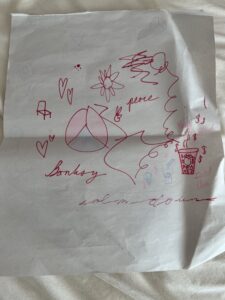
The Woman Who Gave Birth to Rabbits by Stephen Gracia – Elisa Ujkashi
My journey to experience The Woman Who Gave Birth to Rabbits began with a small sweet-treat at Magnolia Bakery. Stopping in for a treat, I picked up a really delicious vanilla cupcake and ordered a venti iced chai latte to keep me going. This was my first time ever at the Macaulay building and I was definitely looking forward to seeing it for the first time. The Macaulay Honors sign in front of the brownstone was definitely instagram/picture-worthy. Also, being in the only physical building designated for specifically Macaulay students was extremely exciting. With my cupcake and Starbucks drink in hand, I felt ready to dive into what I’d heard was a unique and captivating play reading.
The Woman Who Gave Birth to Rabbits, written by Stephen Gracia, was intriguing from the start, but my appreciation for it deepened as I learned more about the people behind the production. At first, I was a little skeptical about the premise of the play. Why rabbits? What specific meaning did they play? I knew that the rabbits had to have a specific significance as opposed to other animals. Knowing more about Gracia’s background, his interest in blending historical oddities with social issues, added layers to my understanding of the play’s complex narrative and heightened my appreciation for his work.
Additionally, the actors’ commitment to their characters was striking. Learning about their backgrounds, techniques, and motivations brought a fresh perspective to their performances, allowing me to appreciate the nuances in their portrayals. The way they embodied their characters’ emotions, especially in such an unconventional story, gave life to the oddities and quirks within the play. Hearing career tips and advice from the actors as well was also extremely inspiring. It was so interesting to learn about their “day jobs” outside of pursuing the arts and how they incorporate acting/the arts in their everyday lives.
All in all, I was extremely impressed with my experience in the city and this was yet again another experience that opened my eyes to how art is made and what truly classifies as art. The play reading represented how much the meaning of art changes once the viewer themselves gain sufficient enough background context. In this scenario, I definitely appreciated the play much more when I met face-to-face with the writer himself and heard his approach and personal stories.
Night at the Museum – Elisa Ujkashi
Attending the Night at the Museum event as part of the Macaulay experience was such a unique and exciting experience. From the moment I walked in, I knew this wasn’t going to be just another museum trip. The atmosphere was electric and it was so interesting and fun to have the class of 2028 in one space.
One of the highlights for me was seeing the giant “YO” sculpture outside. As soon as I spotted it, I couldn’t resist taking a picture of it. The bold yellow letters stood out brilliantly against the night sky, giving off such a playful vibe. It felt like a modern and welcoming piece of art that invited everyone to engage with it. The lighting around it also added to the overall atmosphere, it was lively and exciting, setting the tone for the rest of the night. That sculpture definitely made me laugh as it was so prominent and informal, not something that I normally associate with formal museum buildings.
Inside the museum, the vibe shifted to something more cozy and intimate. The room that caught my attention had this amazing retro decor. The green walls and warm lighting created a nostalgic atmosphere that felt like stepping back in time. The hanging lights, with their intricate designs, gave off a soft glow, which made the space feel comfortable and homey. I couldn’t help but feel drawn to the shelves, which were filled with vintage objects like old televisions, radios, and other memorabilia. It was almost like being in a living room from another era, and I found myself wondering about the stories behind each item. The whole setting was so carefully curated that it made me reflect on the history behind these objects while also appreciating the artistic design of the space.
Throughout the evening, I found myself constantly engaged, whether it was with modern art like the “YO” sculpture or the more historically themed rooms inside. The variety of exhibits kept everything fresh and interesting. I also enjoyed being there with other Macaulay students, exploring the museum together, and having conversations about what we were seeing.
Overall, the “Night at the Museum” was both fun and thought-provoking. I loved how the exhibits offered a mix of playfulness and depth, making it an unforgettable experience that was far more engaging than a typical museum visit.
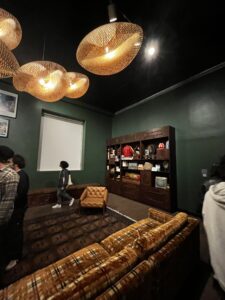

Visit to the Banksy Museum – Elisa Ujkashi
I recently had the chance to check out some replicas of Banksy’s work in person, and it left me thinking about how his art manages to be funny, sarcastic, and deeply critical all at once. Two pieces in particular caught my attention because of how they tackle big social issues in really clever ways.
The first piece shows two elderly women sitting in armchairs, casually knitting like it’s just another day. But what they’re knitting isn’t your usual cozy sweater. One has “Punks Not Dea d” and the other has “Thug For Life” stitched into their blankets. It’s such a great contrast – these sweet old ladies who you’d normally associate with quiet afternoons are sitting there with phrases that scream rebellion and toughness. It’s like Banksy is saying that the spirit of punk and defiance isn’t just for the young. It doesn’t disappear just because you age. This piece made me smile, thinking about how rebellion and resistance to conformity can stick with us, even when society expects us to mellow out.
d” and the other has “Thug For Life” stitched into their blankets. It’s such a great contrast – these sweet old ladies who you’d normally associate with quiet afternoons are sitting there with phrases that scream rebellion and toughness. It’s like Banksy is saying that the spirit of punk and defiance isn’t just for the young. It doesn’t disappear just because you age. This piece made me smile, thinking about how rebellion and resistance to conformity can stick with us, even when society expects us to mellow out.
The second artwork, Show Me the Monet, is a more in-your-face critique of how consumerism and waste impact the environment. It’s based on Monet’s famous Water Lilies painting, but Banksy throws in abandoned shopping carts and a traffic cone floating in the peaceful water. It’s kind of shocking to see this serene landscape disrupted by symbols of modern waste. The title is a clever twist too poking fun at how art is often reduced to its monetary value while also pointing to how consumer culture is literally trashing nature. The plaque next to it explains that Banksy wanted to highlight how overconsumption is destroying the environment. I couldn’t help but think about how true this is, and how we often romanticize nature while continuing to harm it.
Banksy’s art really got me thinking about how he uses humor and irony to push us to question the world around us. These pieces are funny, but they’re also holding up a mirror to our behavior, making us reconsider what we value and how we live. It’s pretty amazing how art can spark those kinds of reflections, even when it’s as funny and unserious as Banksy’s.
The Counter – Elisa Ujkashi
 Watching The Counter at the Roundabout Theater was an unexpectedly moving experience for me. At first, I thought it would be a simple play about a waitress and a regular customer in a small-town diner. As the story unfolded, however, it became so much more, a profound exploration of human connection, loneliness, and the burdens we sometimes place on others.
Watching The Counter at the Roundabout Theater was an unexpectedly moving experience for me. At first, I thought it would be a simple play about a waitress and a regular customer in a small-town diner. As the story unfolded, however, it became so much more, a profound exploration of human connection, loneliness, and the burdens we sometimes place on others.
The characters of Katie and Paul, played brilliantly by Susannah Flood and Anthony Edwards, drew me in immediately. Their relationship starts in such an ordinary way, with Katie refilling Paul’s coffee, but there’s an emotional depth that’s slowly revealed as they open up to each other. The use of the passage of time throughout the play shows the first-person thoughts and feelings of Katie and Paul, which truly revealed the emotions that they both shared for one another. I found myself relating to Katie’s guarded demeanor, perhaps because it reminded me of those times when you’re going through something personal and, unexpectedly, someone in your life helps you carry that weight, even for just a moment.
The most powerful part of the play, for me, was when Paul makes a shocking request asking Katie to poison his coffee within the next couple of months, which ultimately forces both characters to confront their innermost fears and secrets. It made me think about how our everyday interactions, even the ones that seem trivial, can have such lasting effects on us. There’s a beautiful tension between humor and heaviness in the script, which is a testament to Meghan Kennedy’s writing. One moment I was chuckling at a light-hearted exchange, and the next, I was on the edge of my seat, wondering how these characters would navigate their intense, deeply personal emotions.
The diner setting was simple yet perfect. It felt intimate, as if I was sitting at the counter with them, observing their lives unfold. The minimalism of the set allowed the actors’ performances to really shine, and it made the emotional stakes feel even more palpable. The actors’ emotions and actions truly shone through the simple setting and made the emotional outbreaks even more prominent and touching. This play reminded me of my favorite episode from the show, Friends, called “The One Where No One’s Ready”. The premise of the episode is the fact that the camera never leaves the living room of Monica and Rachel’s apartment until the characters are all ready for an event in which they leave together, which is where the episode ends. The hilarious dialogue of Joey saying, “Look at me – I’m Chandler! Could I *be* wearing any more clothes?” as he is wearing 100 layers of Chandler’s clothes will forever be one of the most iconic quotes of the show. The simplicity of the setting, as the characters crack joke after joke and stress about what they have to wear to the event further highlights the incredible dynamic that the actors have with one another, very similar to the actors in The Counter.
What struck me the most about The Counter was how it left me reflecting on my own relationships, how even the smallest gestures or conversations can mean so much more than we realize at the time. The play’s exploration of deep themes like grief, loneliness, and moral ambiguity felt universal. I left the theater thinking about the people in my life and the roles we play for each other, whether we realize it or not. In short, The Counter isn’t just a story about a waitress and her customer. It’s about life, how we navigate our connections, and how even the most ordinary relationships can change the discourse of our lives.
Protest Art- Elisa Ujkashi
The Art:
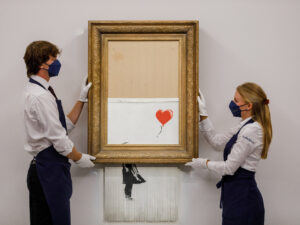
My Comment:
In 2018, Banksy, the anonymous street artist known for his provocative works, shocked the art world when his painting *Girl with Balloon* partially shredded itself immediately after being sold for £1.04 million at a Sotheby’s auction. A shredder, hidden in the frame, activated just as the gavel dropped, cutting the artwork into strips. This act of self-destruction was seen as a critique of the commercialization of art, highlighting the absurdity of its commodification and the way it’s often valued more as a status symbol than for its message. What interests me the most about this piece of protest art is how Banksy completely transformed the original message the painting had to an entirely new one. The stunt resonated with many as a bold statement against the elitism of the art market, reinforcing Banksy’s reputation as a protest artist who challenges societal norms. Banksy’s choice to shred his piece of art immediately after it was bought forms his art into a completely different message of critique and disgust towards the value that society places on how market value defines how important a piece of art actually is.
My Trip to the Rubin Museum of Art – Elisa Ujkashi
My trip to the Rubin Museum of Art was filled with so many eye-opening and interesting experiences. However, the art definitely grew even further on me as I write this blog post and reflect on what interested me the most. At first, I was very unsure of what to expect. I specifically chose the Rubin with the knowledge of its closing on October 6th, so I knew I had to go take the opportunity to see it one last time. As soon as I walked in and bought my ticket, I noticed the museum’s popularity immediately as it was substantially busy. I did no prior research as to what art pieces the museum held, so I went in with a very open mindset in what I was about to experience and see!
EXHIBIT 1: MUTED EXPRESSIONS, TSHERIN SHERPA
I wanted to start with the exhibit that truly resonated with me the most: Muted Expressions by Tsherin Sherpa. The bronze statue represents so much more than what is shown to the eye. It represents the effects of a devastating earthquake Nepal faced in April of 2015. At first glance, I was impressed by the size of the art, yet confused about why it was such a vocal point to the room.
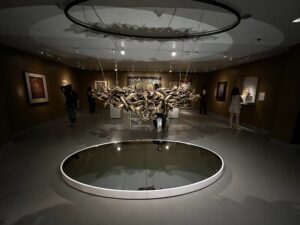 An employee of the museum approached my sister and me, explained the statue’s story, and pointed out the most intricate details only the trained eye could see. The employee explained the “rock on” and “peace” symbols shown in the front and back of the statue among the traditional hand poses in Hinduism and Buddhism. Seeing the employee’s passion for art truly inspired me to learn more about the Himalayan culture and how artists could incorporate both modern and traditional aspects of their respective backgrounds. I saw an example of this as well with a statue called the “Uber Rat,” in which the Buddhist sacred animal, the rat, is wearing headphones while looking like a yellow NYC taxi cab. All in all, learning about the inspiration and story behind a piece of art, however meaningful it actually is, truly transforms the image and offers a new perspective of a piece of art that one may have never come up with beforehand.
An employee of the museum approached my sister and me, explained the statue’s story, and pointed out the most intricate details only the trained eye could see. The employee explained the “rock on” and “peace” symbols shown in the front and back of the statue among the traditional hand poses in Hinduism and Buddhism. Seeing the employee’s passion for art truly inspired me to learn more about the Himalayan culture and how artists could incorporate both modern and traditional aspects of their respective backgrounds. I saw an example of this as well with a statue called the “Uber Rat,” in which the Buddhist sacred animal, the rat, is wearing headphones while looking like a yellow NYC taxi cab. All in all, learning about the inspiration and story behind a piece of art, however meaningful it actually is, truly transforms the image and offers a new perspective of a piece of art that one may have never come up with beforehand.

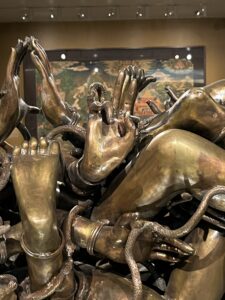
(Different perspectives and details of the instillation)
EXHIBIT 2: COMPASSION, Jasmine Rajbhandari
Out of all of the paintings in one specific area of the museum, I was immediately drawn to Compassion the most. The red figures against the stark yellow background were extremely eye-catching and unique from a lot of the tapestries that were surrounding it. This painting’s visual aesthetic really intrigued me more than other aspects, and I really loved the vibrant colors of the paint. Looking closer, I saw the artist’s technique and how they strategically painted the yellow surrounding the figures in the painting. I remember admiring the effort and accuracy it must have taken to use such a bold color to surround the very intricate figures. After reading the description, the painting was about a Buddhist tradition called the Panchadan Festival that centered on men helping women and children during a war. Instead of representing human men assisting the women, the red figures in the painting actually represented the five Buddhist structures that would traditionally provide aid during times of war.
drawn to Compassion the most. The red figures against the stark yellow background were extremely eye-catching and unique from a lot of the tapestries that were surrounding it. This painting’s visual aesthetic really intrigued me more than other aspects, and I really loved the vibrant colors of the paint. Looking closer, I saw the artist’s technique and how they strategically painted the yellow surrounding the figures in the painting. I remember admiring the effort and accuracy it must have taken to use such a bold color to surround the very intricate figures. After reading the description, the painting was about a Buddhist tradition called the Panchadan Festival that centered on men helping women and children during a war. Instead of representing human men assisting the women, the red figures in the painting actually represented the five Buddhist structures that would traditionally provide aid during times of war.
EXHIBIT 3:
Lastly, the interactive exhibits were fascinating and entertaining. One exhibit that particularly stood out to me and my sister was the one related to scents. It was a fascinating and entertaining experience to be able to smell such specific scents coming out of machines. This reminded me of the way scents are pumped during rides at Disney to fully immerse the park guests, but in the case of the Rubin Museum, I was immersed in different scents and smells from regions worldwide. Some of the scents were unique and exotic, while others were familiar and welcoming. My favorite scent can be seen in the video with this link: IMG_7698 .
Conclusion:
All in all, the overall span of Himalayan culture represented in art is truly inspiring to see. At the Rubin, I saw Himalayan culture shown through gongs, scents, and even CGI characters. It truly opens your eyes to life outside of Western culture and the values that other cultures and religions hold. Referring back to what I said in the beginning, I recognized the art’s true meaning when I was able to see the blend of Western and Himalayan culture that the exhibits at the Rubin held. As I learn more about the culture and story behind the exhibits shown above, the exhibits become more significant and hold an even deeper value. It is such a unique experience to be entirely surrounded by Himalayan artwork and culture in the middle of one of the world’s most bustling cities. I am so disappointed that I only learned about the Rubin due to its closing, however, my great experience has inspired me to further my journey in improving my knowledge of art. At the end of my visit, I wrote an inspirational message on a prayer flag that represented one of five Buddhist elements, which will be hung on the day the Rubin closes.

